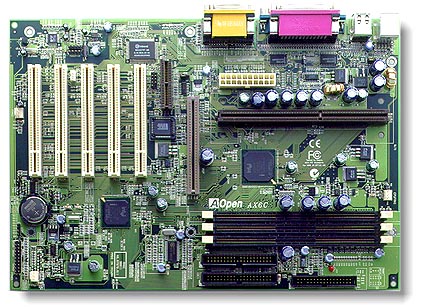AnandTech heeft een review van de AOpen AX6C en AX6C-L online gezet, een i820 plank met respectievelijk 2 en 3 Rambus sockets. Naast de gebruikelijke hoogwaardige kwaliteit die we van AOpen mogen verwachten heeft dit bord voor overklokkers een aantal erg interessante features, waaronder een flinke sloot busspeeds en de unieke mogelijkheid om de Rambus snelheid onafhankelijk van de busspeed te tweaken:
The AX6C does carry a very impressive set of overclocked FSB settings which are a part of the following supported frequencies: 100 / 105 / 114 / 120 / 124 / 128 / 133 / 138 / 143 / 148 / 150 / 152.5 / 155 / 160MHz.The setup for clock multipliers and FSB settings is controlled entirely within the board's Firmware Hub (FWH), which is driven by the AWARD 6.00PG BIOS Setup. However, the truly unique feature of this jumperless setup is the ability to control the RDRAM clock multiplier manually.
For those of you that aren't aware of it, the RDRAM on an i820 motherboard operates at a multiplier of the FSB setting. The way the i820 chipset determines the available RDRAM clock multipliers is by looking at the FSB setting and unlocking certain multipliers and locking others. For example, if you set your CPU to run at a 100MHz FSB setting, the only RDRAM clock multipliers that will be available to you by default will be the 3.0x and 4.0x multipliers (3.0 x 100MHz = 300MHz = PC600 RDRAM and 4.0 x 100MHz = 400MHz = PC800 RDRAM). At the 133MHz FSB setting you get a different set of multipliers, the 2.0x, 2.66x and 3.0x.
AOpen takes the RDRAM speed tweaking one level further, allowing you to select all of the available RDRAM multipliers independently, regardless of the FSB setting. This means that you can use the 2.0x, 2.25x, 2.66x, 3.0x, 3.55x, and 4.0x RDRAM clock multipliers regardless of what FSB setting you pick. AOpen doesn't list the multipliers as being RDRAM frequency multipliers, rather they list the end result which would be the RDRAM speed. Since RDRAM transfers on both the rising and falling edges of the clock, simply double the aforementioned clock multipliers to get what AOpen refers to as the RDRAM Ratio in the BIOS setup.
 |

